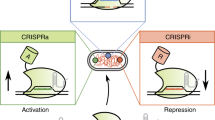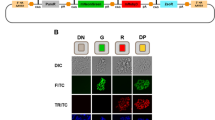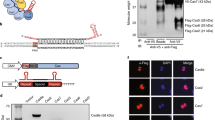Abstract
The ability to modify multiple genetic elements simultaneously would help to elucidate and control the gene interactions and networks underlying complex cellular functions. However, current genome engineering technologies are limited in both the number and the type of perturbations that can be performed simultaneously. Here, we demonstrate that both Cas12a and a clustered regularly interspaced short palindromic repeat (CRISPR) array can be encoded in a single transcript by adding a stabilizer tertiary RNA structure. By leveraging this system, we illustrate constitutive, conditional, inducible, orthogonal and multiplexed genome engineering of endogenous targets using up to 25 individual CRISPR RNAs delivered on a single plasmid. Our method provides a powerful platform to investigate and orchestrate the sophisticated genetic programs underlying complex cell behaviors.
This is a preview of subscription content, access via your institution
Access options
Access Nature and 54 other Nature Portfolio journals
Get Nature+, our best-value online-access subscription
$29.99 / 30 days
cancel any time
Subscribe to this journal
Receive 12 print issues and online access
$259.00 per year
only $21.58 per issue
Buy this article
- Purchase on Springer Link
- Instant access to full article PDF
Prices may be subject to local taxes which are calculated during checkout






Similar content being viewed by others
Data availability
The data that support the findings of this study are available from the corresponding author upon reasonable request. The datasets generated during the current study are available in the NCBI Sequence Read Archive (BioProject ID PRJNA530879). The data sets generated and/or analysed during the current study are available from the corresponding author upon reasonable request. The custom scripts used for the described data analysis areavailable on the Platt Laboratory website (http://www.platt.ethz.ch).
References
Knott, G. J. & Doudna, J. A. CRISPR-Cas guides the future of genetic engineering. Science 361, 866–869 (2018).
Sander, J. D. & Joung, J. K. CRISPR-Cas systems for editing, regulating and targeting genomes. Nat. Biotechnol. 32, 347–355 (2014).
Konermann, S. et al. Genome-scale transcriptional activation by an engineered CRISPR-Cas9 complex. Nature 517, 583–588 (2015).
Shalem, O., Sanjana, N. E. & Zhang, F. High-throughput functional genomics using CRISPR-Cas9. Nat. Rev. Genet. 16, 299–311 (2015).
Gilbert, L. A. et al. CRISPR-mediated modular RNA-guided regulation of transcription in eukaryotes. Cell 154, 442–451 (2013).
Mali, P. et al. CAS9 transcriptional activators for target specificity screening and paired nickases for cooperative genome engineering. Nat. Biotechnol. 31, 833–838 (2013).
Maeder, M. L. et al. CRISPR RNA-guided activation of endogenous human genes. Nat. Methods 10, 977–979 (2013).
Perez-Pinera, P. et al. RNA-guided gene activation by CRISPR-Cas9-based transcription factors. Nat. Methods 10, 973–976 (2013).
Cheng, A. W. et al. Multiplexed activation of endogenous genes by CRISPR-on, an RNA-guided transcriptional activator system. Cell Res. 23, 1163–1171 (2013).
Qi, L. S. et al. Repurposing CRISPR as an RNA-guided platform for sequence-specific control of gene expression. Cell 152, 1173–1183 (2013).
Zalatan, J. G. et al. Engineering complex synthetic transcriptional programs with CRISPR RNA scaffolds. Cell 160, 339–350 (2015).
Boettcher, M. et al. Dual gene activation and knockout screen reveals directional dependencies in genetic networks. Nat. Biotechnol. 36, 170–178 (2018).
Dahlman, J. E. et al. Orthogonal gene knockout and activation with a catalytically active Cas9 nuclease. Nat. Biotechnol. 33, 1159–1161 (2015).
Kiani, S. et al. Cas9 gRNA engineering for genome editing, activation and repression. Nat. Methods 12, 1051–1054 (2015).
Bikard, D. et al. Programmable repression and activation of bacterial gene expression using an engineered CRISPR-Cas system. Nucleic Acids Res. 41, 7429–7437 (2013).
Leenay, R. T. et al. Identifying and visualizing functional PAM diversity across CRISPR-Cas systems. Mol. Cell 62, 137–147 (2016).
Rogers, J. K. & Church, G. M. Multiplexed engineering in biology. Trends Biotechnol. 34, 198–206 (2016).
Xie, K., Minkenberg, B. & Yang, Y. Boosting CRISPR/Cas9 multiplex editing capability with the endogenous tRNA-processing system. Proc. Natl Acad. Sci. USA 112, 3570–3575 (2015).
Nissim, L., Perli, S. D., Fridkin, A., Perez-Pinera, P. & Lu, T. K. Multiplexed and programmable regulation of gene networks with an integrated RNA and CRISPR/Cas toolkit in human cells. Mol. Cell 54, 698–710 (2014).
Ruiz-Mirazo, K., Briones, C. & de la Escosura, A. Chemical roots of biological evolution: the origins of life as a process of development of autonomous functional systems. Open Biol. 7, 170050 (2017).
Fonfara, I., Richter, H., Bratovic, M., Le Rhun, A. & Charpentier, E. The CRISPR-associated DNA-cleaving enzyme Cpf1 also processes precursor CRISPR RNA. Nature 532, 517–521 (2016).
Zetsche, B. et al. Cpf1 is a single RNA-guided endonuclease of a class 2 CRISPR-Cas system. Cell 163, 759–771 (2015).
Swarts, D. C., van der Oost, J. & Jinek, M. Structural basis for guide RNA processing and seed-dependent DNA targeting by CRISPR-Cas12a. Mol. Cell 66, 221–233.e224 (2017).
Wu, W. Y., Lebbink, J. H. G., Kanaar, R., Geijsen, N. & van der Oost, J. Genome editing by natural and engineered CRISPR-associated nucleases. Nat. Chem. Biol. 14, 642–651 (2018).
Zetsche, B. et al. Multiplex gene editing by CRISPR-Cpf1 using a single crRNA array. Nat. Biotechnol. 35, 31–34 (2017).
Zhong, G., Wang, H., Li, Y., Tran, M. H. & Farzan, M. Cpf1 proteins excise CRISPR RNAs from mRNA transcripts in mammalian cells. Nat. Chem. Biol. 13, 839–841 (2017).
Tak, Y. E. et al. Inducible and multiplex gene regulation using CRISPR-Cpf1-based transcription factors. Nat. Methods 14, 1163–1166 (2017).
Arimbasseri, A. G., Rijal, K. & Maraia, R. J. Comparative overview of RNA polymerase II and III transcription cycles, with focus on RNA polymerase III termination and reinitiation. Transcription 5, e27639 (2014).
Wilusz, J. E. et al. A triple helix stabilizes the 3’ ends of long noncoding RNAs that lack poly(A) tails. Genes Dev. 26, 2392–2407 (2012).
Meyers, R. A. Encyclopedia of Molecular Cell Biology and Molecular Medicine 2nd edn (Wiley-VCH, 2004).
Huntley, S. et al. A comprehensive catalog of human KRAB-associated zinc finger genes: insights into the evolutionary history of a large family of transcriptional repressors. Genome Res. 16, 669–677 (2006).
Chavez, A. et al. Highly efficient Cas9-mediated transcriptional programming. Nat. Methods 12, 326–328 (2015).
Singh, D. et al. Real-time observation of DNA target interrogation and product release by the RNA-guided endonuclease CRISPR Cpf1 (Cas12a). Proc. Natl Acad. Sci. USA 115, 5444–5449 (2018).
Schmidt, F. & Platt, R. J. Applications of CRISPR-Cas for synthetic biology and genetic recording. Curr. Opin. Syst. Biol. 5, 9–15 (2017).
Sheth, R. U. & Wang, H. H. DNA-based memory devices for recording cellular events. Nat. Rev. Genet. 19, 718–732 (2018).
Farzadfard, F. & Lu, T. K. Emerging applications for DNA writers and molecular recorders. Sci. 361, 870–875 (2018).
Tennyson, C. N., Klamut, H. J. & Worton, R. G. The human dystrophin gene requires 16 h to be transcribed and is cotranscriptionally spliced. Nat. Genet. 9, 184–190 (1995).
Zoephel, J. & Randau, L. RNA-Seq analyses reveal CRISPR RNA processing and regulation patterns. Biochem. Soc. Trans. 41, 1459–1463 (2013).
Liao, C., Slotkowski, R. A., Achmedov, T. & Beisel, C. L. The Francisella novicida Cas12a is sensitive to the structure downstream of the terminal repeat in CRISPR arrays. RNA Biol. 16, 1–9 (2018).
Liao, C. et al. One-step assembly of large CRISPR arrays enables multi-functional targeting and reveals constraints on array design. Preprint at bioRxiv https://www.biorxiv.org/content/10.1101/312421v1 (2018).
Schmittgen, T. D. & Livak, K. J. Analyzing real-time PCR data by the comparative C(T) method. Nat. Protoc. 3, 1101–1108 (2008).
Heidrich, N., Dugar, G., Vogel, J., Sharma, C. M. & Investigating CRISPR, R. N. A. Biogenesis and function using RNA-seq. Methods Mol. Biol. 1311, 1–21 (2015).
Martin, M. Cutadapt removes adapter sequences from high-throughput sequencing reads. EMBnet. J. 17, 10 (2011).
Langmead, B., Trapnell, C., Pop, M. & Salzberg, S. L. Ultrafast and memory-efficient alignment of short DNA sequences to the human genome. Genome Biol. 10, R25 (2009).
Quinlan, A. R. BEDTools: the Swiss-army tool for genome feature analysis. Curr. Protoc. Bioinforma. 47, 11.12.11–11.12.34 (2014).
Roa, W. et al. Identification of a new microRNA expression profile as a potential cancer screening tool. Clin. Invest. Med. 33, E124 (2010).
Hui, A. B. et al. Comprehensive microRNA profiling for head and neck squamous cell carcinomas. Clin. Cancer Res. 16, 1129–1139 (2010).
Clement, K. et al. CRISPResso2 provides accurate and rapid genome editing sequence analysis. Nat. Biotechnol. 37, 224–226 (2019).
Acknowledgements
We thank the entire Platt Laboratory for productive discussions; C. Beisel, E. Burcklen, K. Eschbach, I. Nissen and M. Kohler from the Genomics Facility Basel for assistance in Illumina sequencing. This project was supported by the Swiss National Science Foundation, ETH domain Personalized Health and Related Technologies, Brain and Behavior Research Foundation, the National Centres of Competence—Molecular Systems Engineering and ETH Zurich. C.C.C. was supported by the ETH Postdoctoral Fellowship.
Author information
Authors and Affiliations
Contributions
C.C.C., N.R.W. and R.J.P. conceived and designed the experiments. C.C.C. and N.R.W. performed the experiments and analyzed the data. A.J.S analyzed the deep sequencing data. D.I. analyzed the RNA-seq data. C.C.C., N.R.W. and R.J.P. wrote the manuscript. All authors reviewed the paper and provided comments.
Corresponding author
Ethics declarations
Competing interests
The authors declare no competing interests.
Additional information
Peer review information: Nicole Rusk was the primary editor on this article and managed its editorial process and peer review in collaboration with the rest of the editorial team.
Publisher’s note: Springer Nature remains neutral with regard to jurisdictional claims in published maps and institutional affiliations.
Integrated supplementary information
Supplementary Fig. 1 Constitutive, conditional and inducible gene editing with SiT-Cas12a.
A. Quantification of gene editing efficiencies by constitutive SiT-Cas12a construct. Values represent mean ± s.e.m., n = 3 independent experiments. B. Quantification of gene editing efficiencies by conditional SiT-Cas12a (SiT-Cas12a-[Cond]) construct. Values represent mean ± s.e.m., n = 3 independent experiments. C. Quantification of gene editing efficiencies by inducible SiT-Cas12a (SiT-Cas12a-[Ind]) construct in either Tet-Off or Tet-On configuration. Values represent mean ± s.e.m., n = 3 independent experiments.
Supplementary Fig. 2 Quantification of SiT-Cas12a-induced gene mutations.
A. Quantification of relative Cas12a mRNA expression in either Cas12a, SiT-Cas12a or SiT-rdCas12a expressing cells. Values represent mean ± s.e.m., n = 3 independent experiments. B. Schematic of the CD47 locus and the target position of crRNA used. C. Quantification of SiT-Cas12a gene editing efficiencies using either single (crRNA 1–10), double (crRNAs 1-2, 3-4, 5-6, 7-8, 9-10), or multiple (comprising crRNA from 4 to 9 or from 1 to 10) spacer sequences targeting the CD47 gene. Values represent mean ± s.e.m., n = 3 independent experiments. D. Quantification of indel size distribution generated in CD47 locus using a CRISPR array containing 10 distinct spacer sequences. Similar results for n = 3 independent experiments. E. Quantification of mutation position distribution generated in CD47 locus using a CRISPR array containing 10 distinct spacer sequences. Similar results for n = 3 independent experiments. F. Quantification of position-dependent deletion size generated in CD47 locus using a CRISPR array containing 10 distinct spacer sequences. Similar results for n = 3 independent experiments. G. Quantification of position-dependent insertion size generated in CD47 locus using a CRISPR array containing 10 distinct spacer sequences. Similar results for n = 3 independent experiments.
Supplementary Fig. 3 Generation of SiT-Cas12a-based lentiviral vector.
A. Schematic of a single transcript lentivirus architecture containing both Cas12a and a CRISPR array in different orientations and its effect on lentivirus production. The transcript encodes for: Cas12a (yellow rectangle); Triplex, a tertiary RNA structural motif (small purple rectangle); direct repeat (DR, grey square); spacer (blue square). The (+)-strand RNA contains a recognizable direct repeat prone to Cas12a-mediated cleavage, preventing functional assembly of virions. On the contrary, direct repeats positioned in inverted orientation are not recognized by Cas12a enabling lentivirus production. B. Schematic of a single transcript lentivirus architecture containing both EGFP and mRNA stabilizer sequences in inverted orientation. The transcript encodes for: EGFP (green rectangle); Woodchuck Hepatitis Virus Posttranscriptional Regulatory Element (WPRE) (small blue rectangle); and a polyadenylation sequence (Poly(A), lilac rectangle). C. Validation of single transcript lentivirus architecture in the inverted orientation. Values represent mean ± s.e.m., n = 3 independent experiments. D. Quantification of percentage of EGFP-positive cells by single transcript lentivirus architectures in the inverted orientation. Values represent mean ± s.e.m., n = 3 independent experiments. E. Quantification of gene editing efficiencies by SiT-Cas12a-based lentivirus harbouring 10 distinct spacer sequences targeting the CD47 gene. Values represent mean ± s.e.m., n = 3 independent experiments.
Supplementary Fig. 4 Multiplexed gene editing with SiT-Cas12a.
A. Quantification of residual CD47-positive cells after SiT-Cas12a-mediated gene editing using single or multiple (10) crRNAs targeting the CD47 gene. Similar results for n = 3 independent experiments. B. Quantification of single, double and triple-negative cells after SiT-Cas12a-mediated gene editing using single or multiple (4) crRNAs targeting the CD47, CD97, and CD166 genes. Values represent mean ± s.e.m., n = 3 independent experiments.
Supplementary Fig. 5 Optimization and characterization of a SiT-Cas12a transcriptional repressor.
A. Schematic of Cas12a transcriptional repressors. Cas12a (yellow rectangle) and repression domain fused (RD, blue rectangle) are indicated. B. Quantification of relative RNA expression for 4 distinct genes (EEA1, RAB5, PIK3C3, RAB7A) using ddCas12a fused with either 1 (KRAB1), 2 (KRAB2) or 3 ([Repr]) KRAB domains and in combination with different crRNA array concentrations. Values represent mean ± s.e.m., n = 3 independent experiments. C. Quantification of relative RNA expression for 2 distinct genes (RAB5A, RAB11A) as a function of the distance between the target and the transcription start site (TSS). Values represent mean ± s.e.m., n = 3 independent experiments.
Supplementary Fig. 6 Optimization and characterization of a SiT-Cas12a transcriptional activator.
A. Schematic of Cas12a transcriptional activators. Cas12a (yellow rectangle) and transactivation domains fused (TAD) are indicated. B. Quantification of relative HBB RNA expression using different Cas12a transcriptional activation domain fusion protein. Values represent mean ± s.e.m., n = 3 independent experiments. C. Quantification of relative RNA expression for 4 distinct genes (IL1B, ASCL1, ZFP42, IL1R2) using ddCas12a fusion proteins (VP128, VPR, [Activ]) in combination with different crRNA array concentrations. Values represent mean ± s.e.m., n = 3 independent experiments. D. Quantification of relative RNA expression of 2 distinct genes (HBB, ASCL1) as a function of the distance between the target and the transcription start site (TSS). Values represent mean ± s.e.m., n = 3 independent experiments. E. Quantification of relative RNA expression as a function of basal gene expression for 10 distinct genes (IL1B, ADRB2, HBB, IL1R2, CCR4, ASCL1, ZFP42, CHRM4, CCR10, HTR6) induced by SiT-Cas12a-[Activ] and 20 distinct spacers targeting those 10 genes. Similar results for n = 3 independent experiments.
Supplementary Fig. 7 Orthogonal genome engineering in the SiT-Cas12a context.
A. Small RNA-seq alignment showing mature short crRNAs (15 bp). B. Quantification of mature crRNAs. n = 2 independent experiments. C. Quantification of relative RNA expression of 4 distinct genes (EEA1, RAB5, PIK3C3, RAB7A) using SiT-ddCas12a-[Repr]. Results from 2 distinct CRISPR arrays are represented. Values represent mean ± s.e.m., n = 3 independent experiments. D. Quantification of relative RNA expression of 2 distinct genes (IL1B, ASCL1) using either SiT-ddCas12a-p65-HSF1 or SiT-ddCas12a-[Activ]. Results from 2 distinct CRISPR arrays are represented. Values represent mean ± s.e.m., n = 3 independent experiments. E. Quantification of relative RNA expression of 2 distinct genes (IL1B, ASCL1) using SiT-ddLbCas12a-VPR. Results from 2 distinct CRISPR arrays are represented. Values represent mean ± s.e.m., n = 3 independent experiments.
Supplementary information
Supplementary Information
Supplementary Figs. 1–7 and Supplementary Note.
Rights and permissions
About this article
Cite this article
Campa, C.C., Weisbach, N.R., Santinha, A.J. et al. Multiplexed genome engineering by Cas12a and CRISPR arrays encoded on single transcripts. Nat Methods 16, 887–893 (2019). https://doi.org/10.1038/s41592-019-0508-6
Received:
Accepted:
Published:
Issue Date:
DOI: https://doi.org/10.1038/s41592-019-0508-6
This article is cited by
-
Prime editing using CRISPR-Cas12a and circular RNAs in human cells
Nature Biotechnology (2024)
-
CRISPR applications in cancer diagnosis and treatment
Cellular & Molecular Biology Letters (2023)
-
Engineered circular guide RNAs boost CRISPR/Cas12a- and CRISPR/Cas13d-based DNA and RNA editing
Genome Biology (2023)
-
Profiling the impact of the promoters on CRISPR-Cas12a system in human cells
Cellular & Molecular Biology Letters (2023)
-
Optimized metrics for orthogonal combinatorial CRISPR screens
Scientific Reports (2023)



